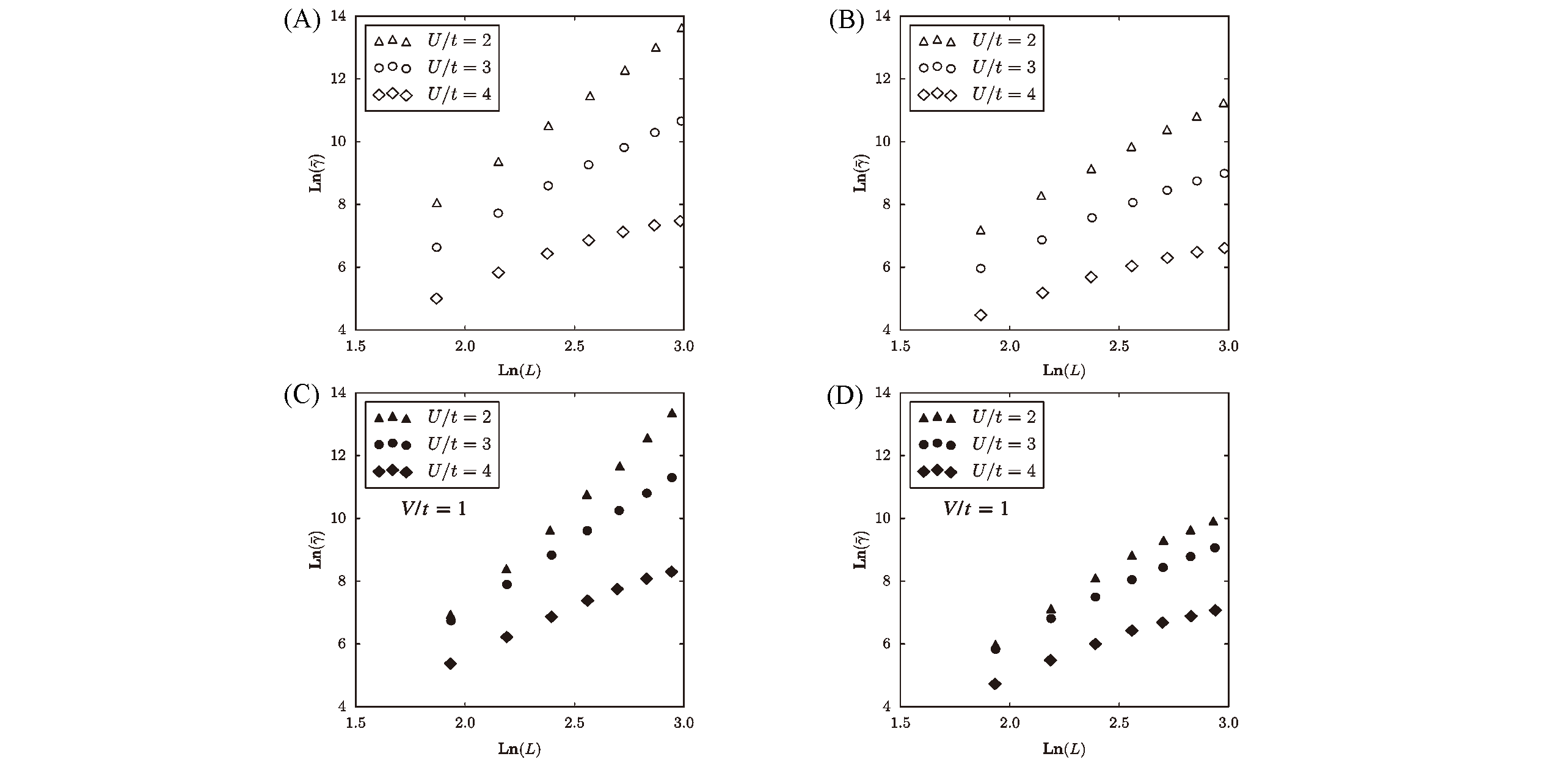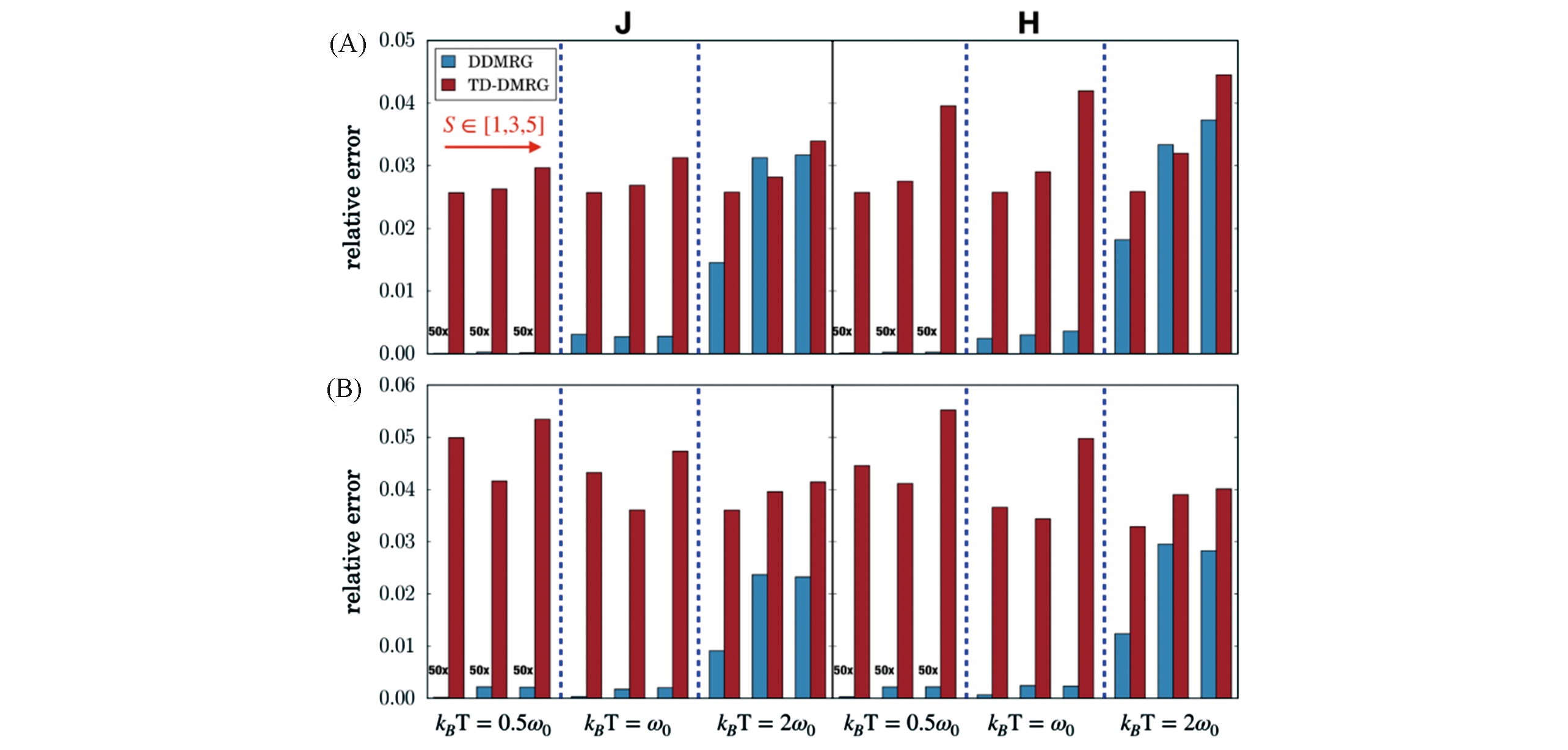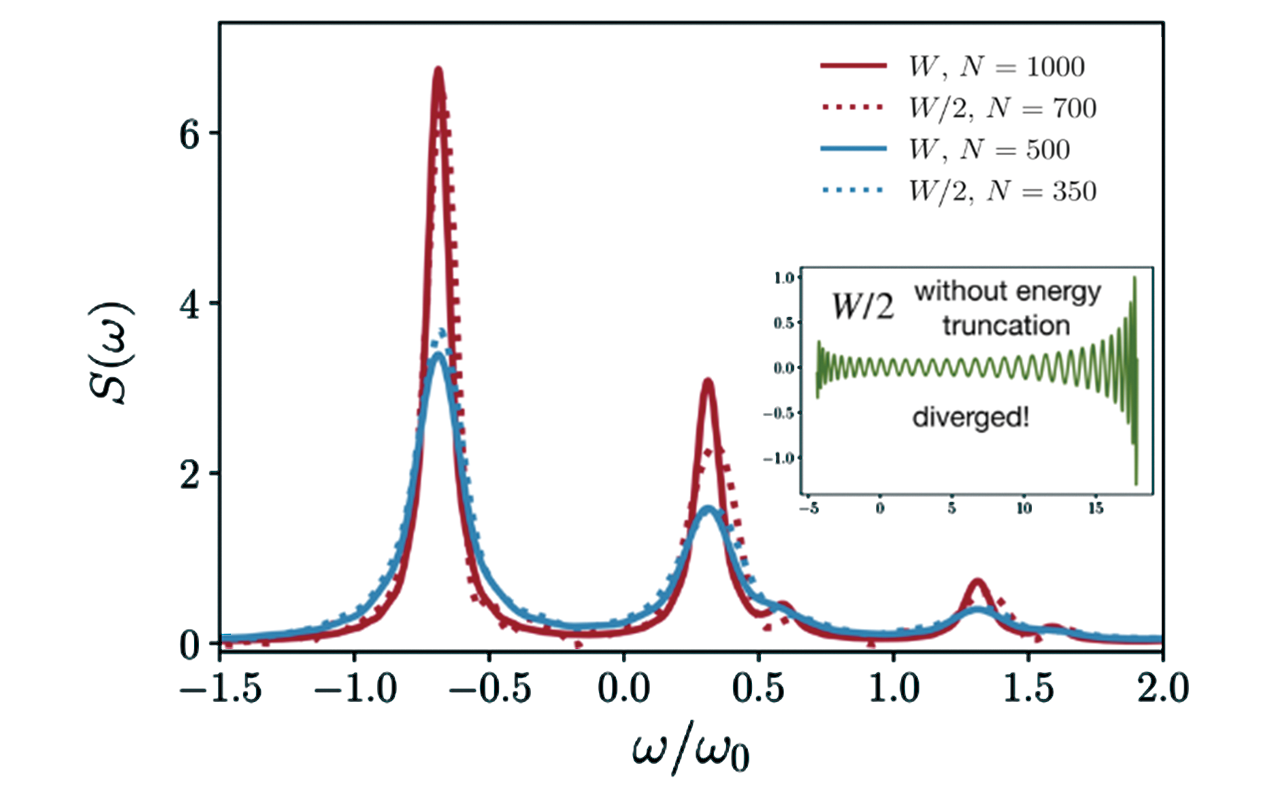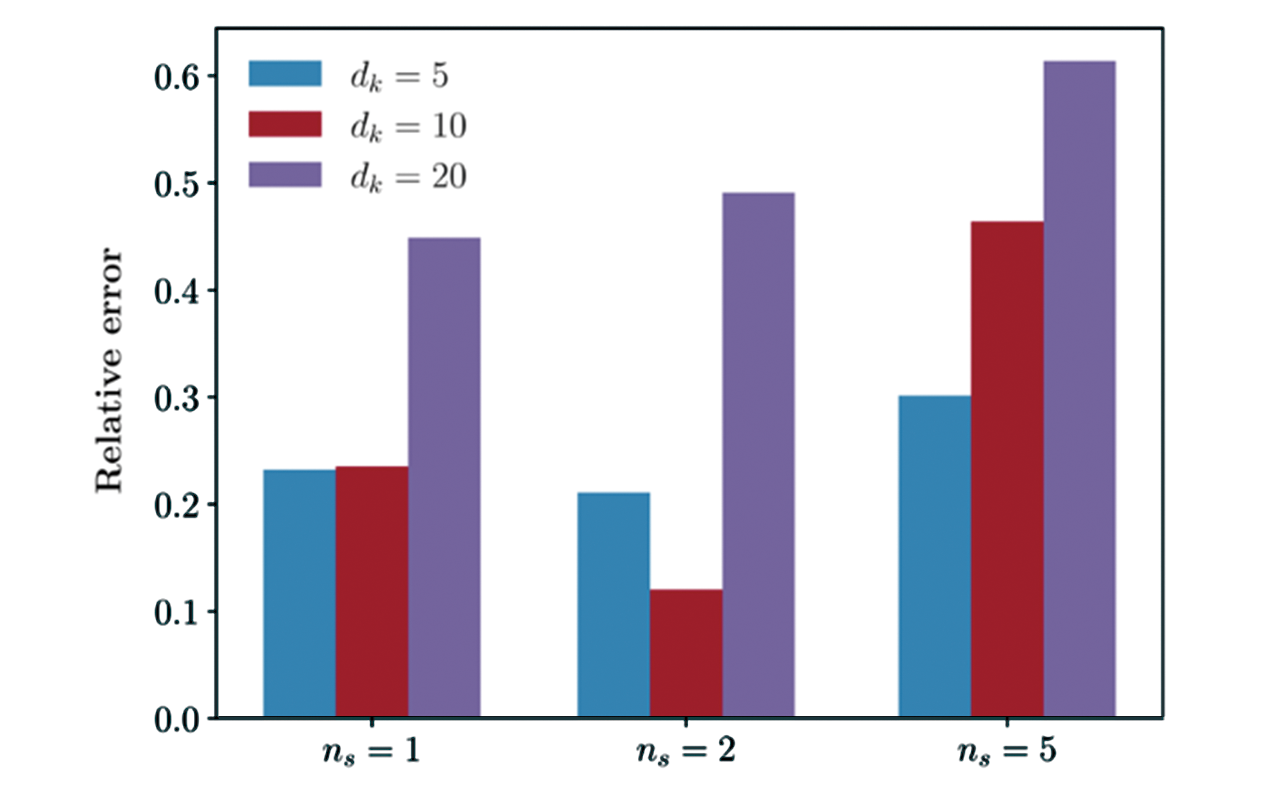

高等学校化学学报 ›› 2020, Vol. 41 ›› Issue (12): 2610.doi: 10.7503/cjcu20200767
• 庆祝《高等学校化学学报》复刊40周年专栏 • 上一篇 下一篇
收稿日期:2020-10-22
出版日期:2020-12-10
发布日期:2020-12-09
通讯作者:
帅志刚
E-mail:zgshuai@tsinghua.edu.cn
基金资助:
JIANG Tong, REN Jiajun, SHUAI Zhigang( )
)
Received:2020-10-22
Online:2020-12-10
Published:2020-12-09
Contact:
SHUAI Zhigang
E-mail:zgshuai@tsinghua.edu.cn
Supported by:摘要:
密度矩阵重正化群(DMRG)作为低维强关联体系中电子结构计算的强有力方法被广泛熟知, 并被迅速地应用于量子化学, 不仅在电子结构计算中发挥重要作用, 同时也在近几年迅速地成为复杂体系量子动力学计算的重要方法. 在DMRG框架中, 衍生出了一系列计算动态响应性质的有效方法, 并得到了广泛应用. 本文简述了DMRG的基本理论, 其矩阵乘积态(MPS)表示有效地扩展了该方法的应用范围. 重点介绍了基于线性响应理论的动态DMRG, 在频率空间求解系统在零温以及有限温度下响应性质的算法, 并介绍其在电子关联问题和电子-声子关联问题中的应用, 最后展望了该领域的未来发展方向.
中图分类号:
TrendMD:
姜童, 任佳骏, 帅志刚. 频域空间密度矩阵重正化群的研究进展. 高等学校化学学报, 2020, 41(12): 2610.
JIANG Tong, REN Jiajun, SHUAI Zhigang. Frequency Domain Density Matrix Renormalization Group. Chem. J. Chinese Universities, 2020, 41(12): 2610.

Fig.1 Graphical representation of matrix product state/operator(MPS/MPO) of wavefunction and operator(A) General wavefunction represented with MPS; (B) operator represented with MPO; (C) mixed?canonical MPS representation of wavefunction, the pink circle is Cσi, matrices to the left is left?normalized(D), to the right is right?normalized(E).

Fig.6 Graphical representation of minimizing the Lagrangian with respect to local matrix Aσi[22](A) Linear equation problem of optimizing Aσi, Aσi is marked in purple; (B) when sweep to left, Singular value decomposition(SVD) of Aσi each time after solving the local linear equation and update the local site Aσi and meanwhile obtain the guess for Aσi-1. Copyright 2020, American Chemical Society.

Fig.8 Linear equation ?F/?Aσi=0(Eq.55) to optimize the local site Aσi(in purple) at finite temperature[22]Aσj(j≠i) is marked in red. The operators ω-H?0, H?0, μ?, ρβ1/2 are shown in blue.Copyright 2020, American Chemical Society.

Fig.10 Plot of the log of average third?order polarizability γˉvs. log of the chain length L[8]Hubbard chain with three different values of U/t for δ=0(A) and δ=0.09(B); Hubbard?Peierls chain with three different values of U/t?and V/t=1 for δ=0(C) and δ=0.09(D).Copyright 1999, American Physical Society.

Fig.11 Optical conductivity calculated by DDMRG[21](A) Peierls insulator with U=0 and δ=0.3, both DDMRG result for a 128?site chain and the exact result in the thermodynamic limit are shown(broadening width η=0.05t); (B) optical conductivity on a 128?site chain for: Mott?Hubbard insulator with U=3t, δ=0(dashed), Peierls insulator with U=0, δ=0.15(dot dashed), and Hubbard?Peierls insulator with U=2.3t, δ=0.075(solid), broadening width η=0.1t.Copyright 2002, American Physical Society.

Fig.12 Dependence ofthe local density of states at the central site of a hydrogen chain(N=10) with different bond dimensions[14]A broadening(η) of 0.005 a.u. has been used. (A) DDMRG result, (B) TD?DMRG result.Copyright 2017, American Chemical Society.

Fig.13 Dynamical properties of Holstein model[43](A) Drude weight D and the kinetic energy per site T as a function of the electron?phonon coupling γ; (B) the incoherent part of the optical conductivity σ'ω? in the quasi?free electron regime(γ=0.3t) and in the small polaron regime(γ=2.5t).

Fig.15 Relative error for J? and H?aggregates with different Huang?Rhys factor(S∈[1.0,3.0,5.0]) across different temperature(kBT∈[0.5ω0,ω0,2ω0])[22]Note the error of DDMRG at kBT=0.5ω0 is magnified by 50 times to make it clearly visible. (A) Absorption; (B) emission.Copyright 2020, American Chemical Society.

Fig.16 0?0 emission strength I0?0 as a function of T-1/2 for different excitonic coupling J0(A linear relation between them is predicted by strong excitonic coupling perturbation theory[59])[22](A) J0=-2.5ω0; (B) J0=-0.25ω0; (C) J0=-0.025ω0.Copyright 2020, American Chemical Society.

Fig.17 Comparison between DDMRG and n?particle approximation[22](A) Relative error of 0?0 emission strength of an open boundary 5?site system using n?particle approximation and DDMRG; (B) the emission spectrum at kBT=ω0 with broadening width η=0.1ω0, the pre?factor of the frequency index of the line strength is omitted.Copyright 2020, American Chemical Society.

Fig.18 Linear absorption spectrum(omit the pre?factor of the frequency index) of dimer model using CheMPS and the comparison with DDMRG(A) At zero temperature T=0; (B)at finite temperature kBT=ω0/2.

Fig.20 Linear absorption spectrum calculated by using effective frequency window and the energy truncation scheme with the Krylov subspace dimension dk=10 and ns=1 sweep times

Fig.21 Relative error using effective band(W*=W/2) at N=700 with respect to the full many body band calculationat N=1000 for different combinations of Krylov subspace dimension dk and sweep times ns for energy truncation
| 1 | White S. R., Phys. Rev. Lett., 1992, 69(19), 2863―2866 |
| 2 | White S. R., Phys. Rev. B: Condens. Matter Mater. Phys., 1993, 48(14), 10345―10356 |
| 3 | Shuai Z., Bredas J. L., Pati S. K., Ramasesha S., Proc. SPIE, 1997, 3145, 293―302 |
| 4 | Shuai Z., Pati S. K., Bredas J. L., Ramasesha S., Synth. Met., 1997, 85(1―3), 1011―1014 |
| 5 | Ramasesha S., Pati S. K., Krishnamurthy H. R., Shuai Z., Brédas J. L., Synth. Met., 1997, 85, 1019―1022 |
| 6 | Shuai Z., Brédas J. L., Saxena A., Bishop A. R., J. Chem. Phys., 1998, 109, 2549―2555 |
| 7 | Yaron D., Moore E. E., Shuai Z., Brédas J. L., J. Chem. Phys., 1998, 108(17), 7451―7458 |
| 8 | Pati S. K., Ramasesha S., Shuai Z., Brédas J. L., Phys. Rev. B: Condens. Matter Mater. Phys., 1999, 59(23), 14827―14830 |
| 9 | White S. R., Martin R. L., J. Chem. Phys., 1999, 110(9), 4127―4130 |
| 10 | Chan G. K. L., Head⁃Gordon M., J. Chem. Phys., 2002, 116(11), 4462―4476 |
| 11 | Vidal G., Phys. Rev. Lett., 2004, 93(4), 40502 |
| 12 | White S. R., Feiguin A. E., Phys. Rev. Lett., 2004, 93(7), 76401 |
| 13 | Haegeman J., Lubich C., Oseledets I., Vandereycken B., Verstraete F., Phys. Rev. B: Condens. Matter Mater. Phys., 2016, 94(16), 165116 |
| 14 | Ronca E., Li Z., Jimenez⁃Hoyos C. A., Chan G. K. L., J. Chem. Theory Comput., 2017, 13(11), 5560―5571 |
| 15 | Ren J., Shuai Z., Chan G. K. L., J. Chem. Theory Comput., 2018, 14(10), 5027―5039 |
| 16 | Li W., Ren J., Shuai Z., J. Chem. Phys., 2020, 152(2), 24127 |
| 17 | Hallberg K. A., Phys. Rev. B: Condens. Matter Mater. Phys., 1995, 52(14), R9827 |
| 18 | Dargel P. E., Honecker A., Peters R., Noack R. M., Pruschke T., Phys. Rev. B: Condens. Matter Mater. Phys., 2011, 83(16), 161104 |
| 19 | Dargel P. E., Wöllert A., Honecker A., McCulloch I. P., Schollwöck U., Pruschke T., Phys. Rev. B: Condens. Matter Mater. Phys., 2012, 85(20), 205119 |
| 20 | Kühner T. D., White S. R., Phys. Rev. B: Condens. Matter Mater. Phys., 1999, 60, 335―343 |
| 21 | Jeckelmann E., Phys. Rev. B: Condens. Matter Mater. Phys., 2002, 66(4), 045114 |
| 22 | Jiang T., Li W., Ren J., Shuai Z., J. Phys. Chem. Lett., 2020, 3761―3768 |
| 23 | Holzner A., Weichselbaum A., McCulloch I. P., Schollwöck U., von Delft J., Phys. Rev. B: Condens. Matter Mater. Phys., 2011, 83(19), 195115 |
| 24 | Tiegel A. C., Manmana S. R., Pruschke T., Honecker A., Phys. Rev. B: Condens. Matter Mater. Phys., 2014, 90(6), 060406 |
| 25 | Dorando J. J., Hachmann J., Chan G. K. L., J. Chem. Phys., 2009, 130(18), 184111 |
| 26 | Wouters S., Nakatani N., van Neck D., Chan G. K. L., Phys. Rev. B: Condens. Matter Mater. Phys., 2013, 88(7), 075122 |
| 27 | Nakatani N., Wouters S., van Neck D., Chan G. K. L., J. Chem. Phys., 2014, 140(2), 24108 |
| 28 | Yao Y., Sun K. W., Luo Z., Ma H., J. Phys. Chem. Lett., 2018, 9(2), 413―419 |
| 29 | Greene S. M., Batista V. S., J. Chem. Theory Comput., 2017, 13(9), 4034―4042 |
| 30 | Baiardi A., Reiher M., J. Chem. Theory Comput., 2019, 15(6), 3481―3498 |
| 31 | Schröder F. A., Turban D. H., Musser A. J., Hine N.D., Chin A. W., Nat. Commun.,2019, 10(1), 1062 |
| 32 | Xie X., Liu Y., Yao Y., Schollwöck U., Liu C., Ma H., J. Chem. Phys., 2019, 151(22), 224101 |
| 33 | Gobert D., Kollath C., Schollwöck U., Schütz G., Phys. Rev. E, 2005, 71(3), 36102 |
| 34 | Barthel T., Schollwöck U., White S. R., Phys. Rev. B: Condens. Matter Mater. Phys., 2009, 79(24), 245101 |
| 35 | Kloss B., Lev Y. B., Reichman D., Phys. Rev. B: Condens. Matter Mater. Phys., 2018, 97, 024307 |
| 36 | Ganahl M., Thunström P., Verstraete F., Held K., Evertz H. G., Phys. Rev. B: Condens. Matter Mater. Phys., 2014, 90(4), 045144 |
| 37 | Haegeman J., Osborne T. J., Verstraete F., Phys. Rev. B: Condens. Matter Mater. Phys., 2013, 88(7), 075133 |
| 38 | Schollwöck U., Ann. Phys., 2011, 326(1), 96―192 |
| 39 | Chan G. K. L., Keselman A., Nakatani N., Li Z., White S. R., J. Chem. Phys., 2016, 145(1), 14102 |
| 40 | Kubo R., J. Phys. Soc. Japan, 1957, 12(6), 570―586 |
| 41 | Mahan G. D., Many⁃Particle Physics, Springer Science & Business Media, Berlin, 2013 |
| 42 | Gagliano E. R., Balseiro C. A., Phys. Rev. Lett., 1987, 59(26), 2999―3002 |
| 43 | Zhang C., Jeckelmann E., White S. R., Phys. Rev. B: Condens. Matter Mater. Phys., 1999, 60(20), 14092―14104 |
| 44 | Yu W., Haas S., Phys. Rev. B: Condens. Matter Mater. Phys., 2000, 63(2), 024423 |
| 45 | Okunishi K., Akutsu Y., Akutsu N., Yamamoto T., Phys. Rev. B: Condens. Matter Mater. Phys., 2001, 64(10), 104432 |
| 46 | Garcia D. J., Hallberg K., Rozenberg M. J., Phys. Rev. Lett., 2004, 93(24), 246403 |
| 47 | Soos Z. G., Ramasesha S., J. Chem. Phys., 1989, 90(2), 1067―1076 |
| 48 | Nocera A., Alvarez G., Phys. Rev. E, 2016, 94(5), 053308 |
| 49 | Silver R. N., Röder H., Int. J. Mod. Phys. C, 1994, 5(4), 735―753 |
| 50 | Wang L. W., Phys. Rev. B: Condens. Matter Mater. Phys., 1994, 49(15), 10154―10158 |
| 51 | Weiße A., Eur. Phys. J. B⁃Condensed Matter Complex Syst., 2004, 40(2), 125―128 |
| 52 | Weiße A., Wellein G., Alvermann A., Fehske H., Rev. Mod. Phys., 2006, 78(1), 275―306 |
| 53 | Umezawa H., Matsumoto H., Tachiki M., Thermo Field Dynamics and Condensed States, North Holland, Amsterdam, 1982 |
| 54 | Verstraete F., Garcia⁃Ripoll J. J., Cirac J. I., Phys. Rev. Lett., 2004, 93(20), 207204 |
| 55 | Zwolak M., Vidal G., Phys. Rev. Lett., 2004, 93(20), 207205 |
| 56 | Feiguin A. E., White S. R., Phys. Rev. B: Condens. Matter Mater. Phys., 2005, 72(22), 220401 |
| 57 | Kokalj J., Prelovšek P., Phys. Rev. B: Condens. Matter Mater. Phys., 2009, 80(20), 205117 |
| 58 | Renormalizer, https://github.com/shuaigroup/Renormalizer |
| 59 | Spano F. C., J. Chem. Phys., 2004, 120(16), 7643―7658 |
| 60 | White S. R., Phys. Rev. Lett., 2009, 102(19), 190601 |
| [1] | 李维唐, 任佳骏, 帅志刚. 含时密度矩阵重正化群的理论与应用[J]. 高等学校化学学报, 2021, 42(7): 2085. |
| [2] | 孙润广, 张静, 郝长春, 陈莹莹, 杨谦. 脂筏微区超分子聚集体结构的稳定性[J]. 高等学校化学学报, 2011, 32(9): 2071. |
| [3] | 李凯, 韩蛟, 张厚玉, ABRAMAVICIUS Darius, 张汉壮. 分子聚集体的光谱模拟[J]. 高等学校化学学报, 2011, 32(12): 2872. |
| [4] | 袁建军, 李英顺, 李小琴, 张小红, 程时远, 江雷, 封麟先. 聚苯乙烯-b-聚氧乙烯-b-聚苯乙烯三嵌段共聚物的自组装[J]. 高等学校化学学报, 2003, 24(2): 371. |
| [5] | 陈东明, 李晓原, 尤乃亭, 章应辉, 何天敬, 刘凡镇. 四-(对-磺基苯基)卟啉二酸(H42+TSPP)分子聚集体的共振喇曼光谱研究[J]. 高等学校化学学报, 1999, 20(7): 1097. |
| [6] | 梁玉增, 李子臣, 李福绵. 两亲性含糖嵌段共聚物在水中分子聚集形态的转变[J]. 高等学校化学学报, 1999, 20(11): 1820. |
| 阅读次数 | ||||||
|
全文 |
|
|||||
|
摘要 |
|
|||||